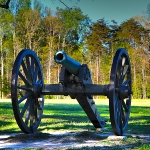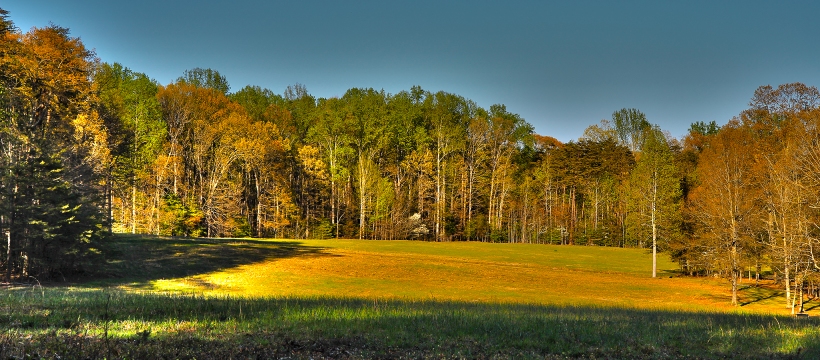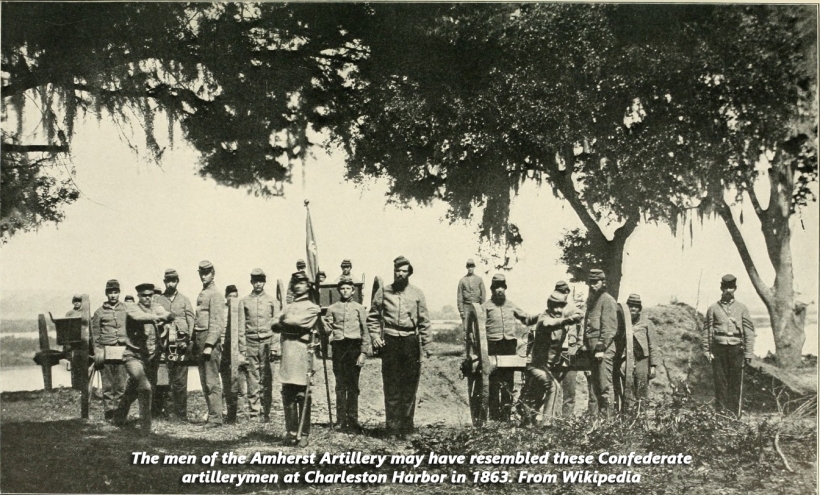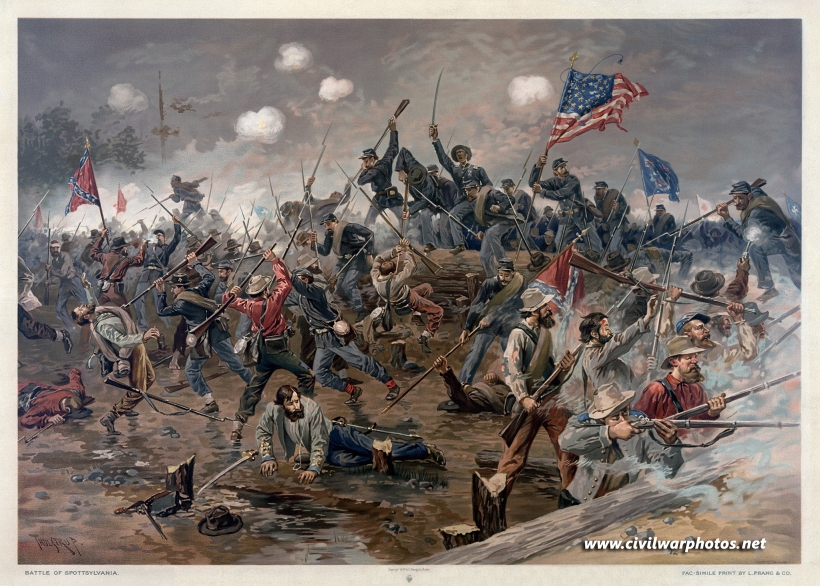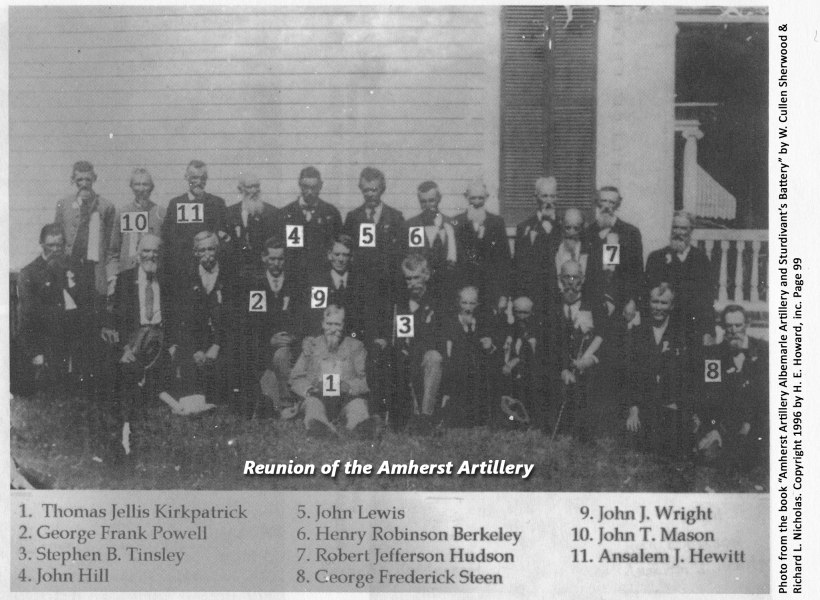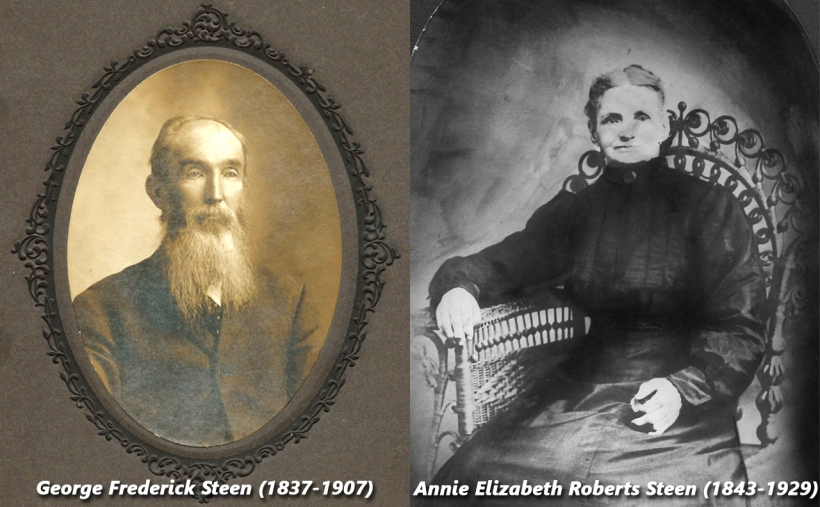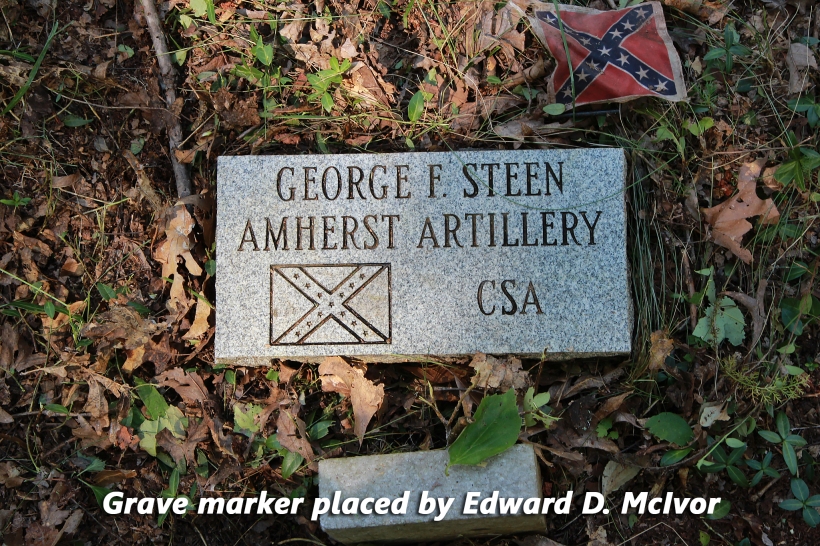On May 5th, 1864, exactly one hundred and fifty-two years ago today, this tranquil field witnessed the beginning of a bloody and chaotic 3-day conflict known as the Battle of the Wilderness. This battle began when Confederate troops led by General Richard Ewell clashed with the Union’s 5th Corps at Saunders Field on both sides of the Orange Turnpike, present day Virginia Route 20. The fierce fighting spread to the forest, at that time thick with dense undergrowth, making organization and orderly maneuvers impossible. Fighting at close quarters in the dense smoke, it was difficult to tell friend from foe, and many infantrymen became separated from their units in the desperate clash. Rifle bursts and exploding shells ignited fires that trapped and killed many of the wounded. At the end of the day on May 7th, the battle was stalemated. The cost: nearly 30,000 total casualties, Confederate and Union combined.
My great-grandfather, Private George Frederick Steen, and my 2nd great-uncle, Private William Daniel McIver, served with Captain Thomas Kirkpatrick’s Amherst Artillery during this tragic event.
The dense undergrowth of the forest and the nature of the terrain made it impossible for effective artillery deployment. Although no journals or letters written by George or William are known to exist, we can get a sense of what they experienced from the diary of a fellow artilleryman, Private Henry Robinson Berkeley of Hanover, Virginia.
May 5 [1864]. Moved early this morning towards Chancellorsville. We came suddenly on the Yanks in the thick woods on the Orange side of Wilderness Tavern. Not being able to get positions for our guns, we went back a short distance into a field on the right of the pike. The infantry fighting very soon became heavy and desperate. The doctors established the field hospital of the 1st and 2nd divisions at a spring near us and very soon they began to bring out the wounded very rapidly. It is a beautiful spring day on which all this bloody work is being done.
A grizzly sight awaited the men of the Amherst Artillery when they awoke the next morning.
All night, our surgeons, some twenty in number, have been cutting off arms, legs, etc., and dressing their wounds. This morning when I got up about 4 A.M. there was a big pile of amputated arms, hands, legs and fingers within a foot or two of me. A horrid sight.
May 6. This morning forty men of my company, I was among the number, were given muskets and forty rounds of ammunition and sent down on our extreme left to act as sharpshooters under Lieut. Basye, who stationed us in a big woods, with orders for us to keep a sharp lookout for Yankee scouts and cavalry. We remained there some four hours without seeing or hearing a single Yank and then reported to our company at Locust Grove. The first gun of our battery was engaged late last night and early this morning, but no one was hurt.
Although Private Berkeley, along with George Steen, William McIver, and the other men from Kirkpatrick’s Battery avoided the worst of the combat at Wilderness, harder days were ahead at Spotsylvania Courthouse. From Amherst Artillery, Albemarle Artillery, and Sturdivant’s Battery by W. Cullen Sherwood and Richard L. Nicholas:
Reinforcements hurried into the maelstrom and the fighting reached a near manic intensity. Man against man, company against company, regiment against regiment – in a sea of mud. Bayonets and rifle butts were used in hand-to-hand combat in, and over, the entrenchments.
Private Berkeley wrote:
May 12. …This has been the most terrible day I have ever lived. At one time, it seemed as if by mere brute force and overpowering numbers that the Yanks would trample us into the mud.
More terrible days followed as the Army of the Potomac, led by General Ulysses S. Grant continued to defeat the southern troops in battle after battle throughout 1864 and into 1865. There were a few victories for the South, but the tide of the war had definitely turned.
The Amherst Artillery’s last battle was at Waynesboro on March 2nd, 1865. A large Union force led by General George Custer overwhelmed the 1500 or so remaining soldiers of General Jubal Early’s Army of the Valley. Most of the Confederate troops were captured, but a few managed to escape by fleeing across the South River and into the mountains. The war lasted just another 38 days. This long and bloody conflict finally came to an end when General Robert E. Lee surrendered to General Grant at Appomattox Court House on April 9th, 1865.
Thankfully, my Confederate ancestors survived this war and all its horrors. George and William returned home to Amherst County, eventually married and raised families.
George Frederick Steen married Annie Elizabeth Roberts in 1874. The Steens resided in Monroe, VA, and raised four children: Walter Clarence, Otway Bascom, Frederick Chapman, and Carrie Elizabeth.
William Daniel McIver married Margaret S. Crockett in 1866, just a year after the war. The McIvers had several children and left their Virginia home in the 1870’s for a pioneer life on the prairies of Decatur County, Kansas. William’s brother, Hugh Eugene McIvor, stayed in Amherst County. Hugh, born in 1848, was only 13 when the war started. After the war, he married Elizabeth Mildred McCaul and they had seven children before his untimely death in a hunting accident in 1894.
Perhaps it was the two Civil War veterans’ service in the same battery that led to William’s nephew (and Hugh’s son), Royal Pitman McIvor meeting Carrie Elizabeth Steen, George’s daughter. However they met, Royal and Carrie fell in love. Their plans for marriage however, must have met with some opposition. Royal was 26 but Carrie was only 19. In Virginia a woman had to be 21 in order to marry without her father’s written consent. Apparently George was not too keen on this young McIvor marrying his only daughter, or maybe the two were just afraid to ask for his permission. Whatever the reason, two weeks after her 20th birthday and just three days before Christmas 1903, these two love birds boarded a train and eloped to Guilford County, North Carolina*, where they joined in holy matrimony. I wonder how great-grandfather George received the news of their elopement. A new son-in-law was probably not the Christmas gift he had hoped for that year.
 So that is the story of William McIver and George Steen, and how the nephew and daughter of these survivors of the Battle of the Wilderness came to be husband and wife. These two sweethearts, Royal and Carrie McIvor, were my grandparents.
So that is the story of William McIver and George Steen, and how the nephew and daughter of these survivors of the Battle of the Wilderness came to be husband and wife. These two sweethearts, Royal and Carrie McIvor, were my grandparents.
*North Carolina’s marriage laws were more lenient at that time. The age of consent for females was just 15 years of age.
Sources:
Sherwood, W. Cullen and Nicholas, Richard L. Amherst Artillery, Albemarle Artillery, and Sturdivant’s Battery. Published 1996.
Berkeley, Henry Robinson. Four Years in the Confederate Artillery: The Diary of Private Henry Robinson Berkeley. Published 1991
Battle of the Wilderness www.history.com/topics/american-civil-war/battle-of-the-wilderness
Fredericksburg & Spotsylvania National Military Park www.nps.gov/frsp/index.htm
19th and 20th century photos are from the album of Carrie Elizabeth Steen McIvor, now in the collection of Wilson McIvor. Royal’s photo is from the collection of Linda McIvor. 21st century photos of the Wilderness Battleground are mine.
A special thanks to the Heritage Research Center, a division of the High Point Museum, City of High Point, North Carolina, for providing the information about North Carolina’s marriage laws, which are referenced from Helen Leary’s North Carolina Research.
Thanks also to Wilson McIvor for his valuable corrections, suggestions, and help in refining this post.

